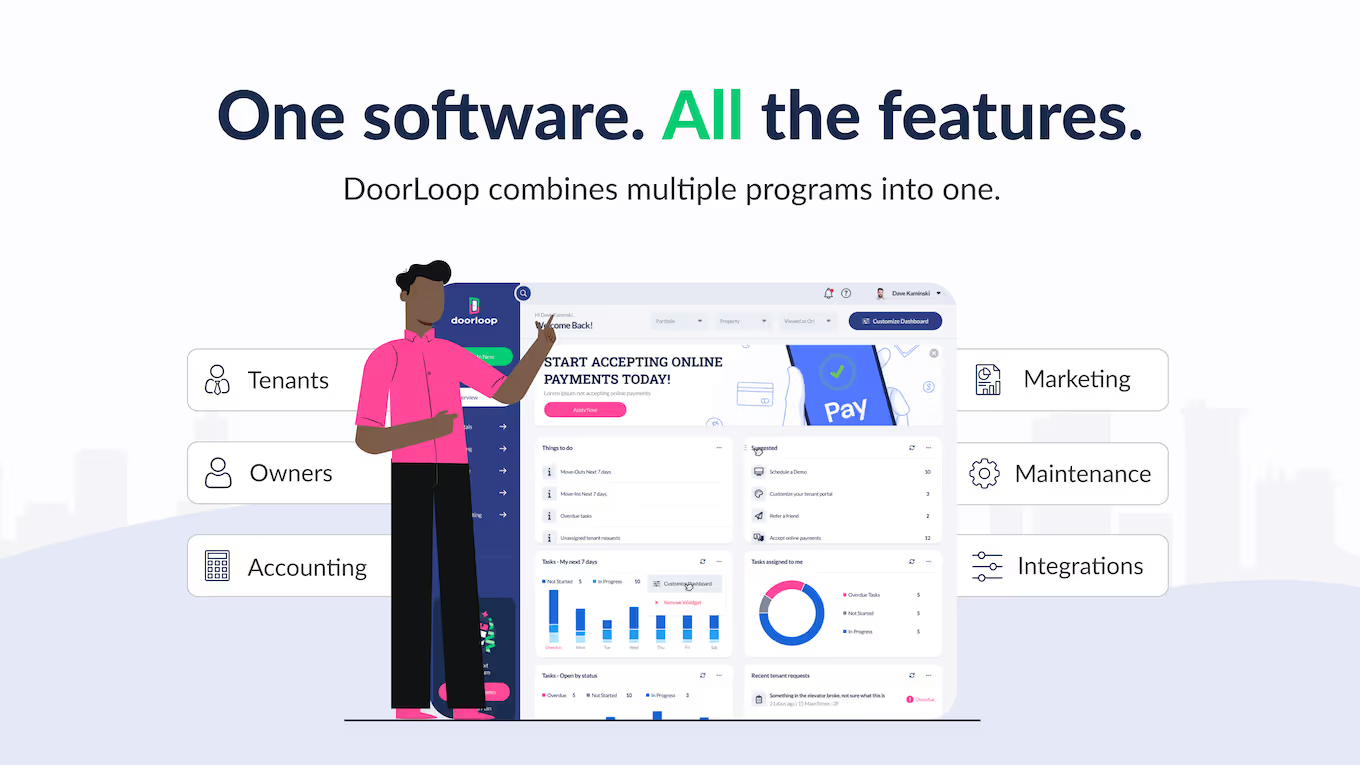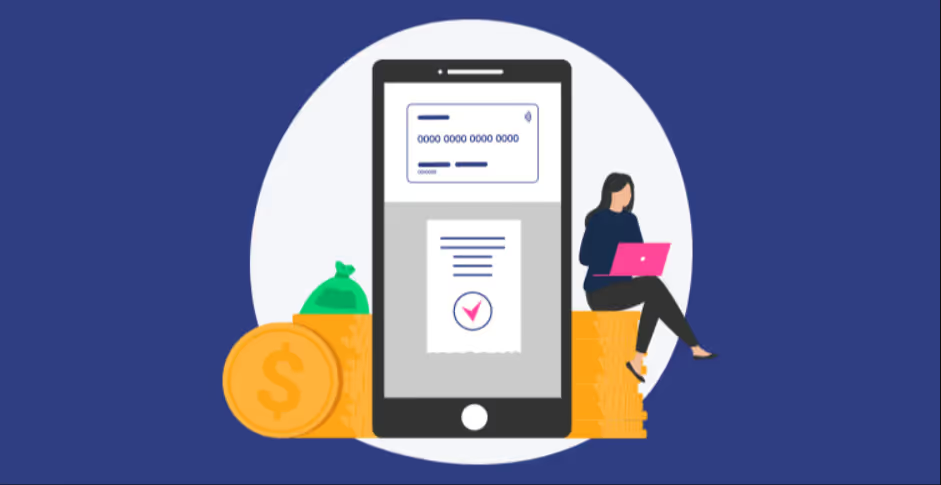Property management is complex and requires multiple moving parts to run smoothly.
Tenant management is one of the most important aspects of that, maybe even the most important.
After all, if you don’t manage your tenants right, you can’t:
- Collect rent effectively
- Keep your units occupied
- Or maintain the property’s condition
- Among other vital things
Whether you’re a new landlord or property manager or you have experience and a team behind you, it can be useful to get back to basics and strengthen your fundamentals.
That’s why, below, we’ll talk about:
- What the responsibilities of a landlord or property manager are
- Tips for managing your tenants more effectively
- And what tenant management software is (and why it’s so important)
Let’s start by outlining what your responsibilities are as a landlord or property manager to get a clear picture.
What are the responsibilities of a landlord or property manager?
As a landlord managing an investment property, or a property manager managing one of your clients, there are a certain set of responsibilities you need to juggle.
Each, when handled effectively, can help maximize profit and maintain the investment property long-term.
Not to mention, they keep the property a safe and comfortable place to live for your tenants.
And that, in turn, keeps them happy and your units occupied.

Those basic responsibilities include:
- Paying bills (utilities, repairs, etc.)
- Day-to-day maintenance
- Regular safety and property checks
- Tenant communications
- And handling issues and other concerns from tenants
Keep in mind that these are all large general categories that include a number of subtasks and responsibilities within them.
For example, within tenant communications, there is:
- Answering maintenance requests
- Communicating with tenants about rent payments, fees, and other tenant financial responsibilities
- Scheduling regular inspections
- Informing tenants of changes to the property and its rules
- And more
This all can be a bit overwhelming if you’re just starting out with your first few properties.
But it doesn’t stop being a handful even if you have years of experience.
It’s with this in mind that we’ll hop to the next section and talk about some tips for managing your tenants more effectively.
The goal? Save you time and make your rental properties more profitable.
7 Tenant management tips
So, let’s talk about tips for managing your tenants.
Keep in mind, these are designed to be helpful to you whether you’re starting out or you have a full portfolio.
We’ll start from the top then move through the process chronologically
1. Proactively handle issues by including the solution in your lease agreements
Before we even get to what you’d typically consider tenant management, let’s talk about a useful proactive step you can take.
(In fact, two proactive steps. See point #2 after this.)
First, consider the types of issues you expect to have or have had in the past with tenants.
Then, consider how you can craft or adjust your lease agreement to do one or more of:
- Prohibiting the activity
- Having a clause that states a repercussion or fee for said offense
- Or clearly outlining some required action by the tenant under a certain event
This all depends on what that potential issue or pain point is that you’re proactively trying to manage, of course.
Plus, your local state and city laws will determine what you’re allowed to include or require by way of your lease agreement.
With this in mind, however, looking at your tenant lease agreement is an effective way to proactively deal with issues and keep them from arising (or at least managing them) moving forward.
2. Invest in a stellar tenant screening process
Another proactive step, this one focuses on making sure you have a thorough tenant screening process.
The reason is simple: the better you screen tenants, the more reliable your ability to bring in high-quality tenants that:
- Pay rent on time
- Take care of your property
- And are generally pleasant to work with
What does a thorough tenant screening process look like? It includes checks for things like:
- Criminal background check
- Credit check
- Bankruptcy and eviction reports
And the best place to get these reports? Property management software.
Traditional methods for obtaining screening reports, even digitally, are either slow or cumbersome, or both.
Some sites offer quick reports, but not the convenience of a property software’s streamlined platform that allows you to organize data in one central place with ease.
There is no one way to screen tenants. However, if you’re looking for a simple and efficient way with multiple levels of screening checks, check out DoorLoop’s comprehensive tenant screening tools.
It also gives you the ability to accept applications online, automatic rent payments, and more:

3. Establish expectations and handle problem tenants swiftly
One of the most important things to do with new tenants is to make expectations clear from the very beginning.
If you’ve ever taught or been a parent, you’ll know the importance of making your expectations clear from the start.
Why is this so important?
Because it’s at the beginning of your relationship with that tenant that they’ll be most receptive to you, and when you’ll both come to establish a dynamic.
If you allow them to get away with turning in rent late, not reporting maintenance issues, or fulfilling any other tenant responsibility, they’ll likely continue to.
Instead, make your expectations clear upfront by outlining them in your lease agreement, policies, and verbal communications.
If you do run into an issue with a tenant, handle it immediately and set the tone for what they should expect from you.
This won’t guarantee a bad tenant becomes a good one, but it will make a so-so tenant a better one and help reduce issues moving forward.
A note on evictions:
Evictions are difficult no matter what. However, it’s vital here to understand local rules and regulations even more than usual.
You need to fully understand your state and local laws regarding things such as how long tenants are allowed to stay in the property from the date of an eviction notice.
This will help you avoid further issues when dealing with a difficult tenant.
4. Establish reliable, professional communication channels for you and your tenants
Communication is key to working with your tenants in every respect, whether it’s communicating about:
- Maintenance requests
- Collecting rent
- Notifying your tenants about policy changes
- Special events
- And anything else
It’s not enough just to have a smartphone and get everyone’s number.
Pretty soon, you’ll have multiple text strings that are hard to keep up with.
Not to mention, ineffective communications records– a real pain if you ever need to pull information to prove anything.
You might have text, phone calls, email, maybe even two phones, all splintered communications that make it impossible to track or really get anything done efficiently.
Fortunately, with something like property management software you can centralize all communications into a single platform, solving these issues.
Regardless, however, you need to make sure that the communications channels you set up are organized and reliable to effectively manage your tenants.
5. Understand tenant privacy rights
A common mistake that landlords often make is not respecting tenant privacy rights.
If you’re not careful, you could land yourself in hot water in two ways:
- Stopping by without notice
- And/or entering the unit or property without permission of the tenant
Both are against the law in most areas within the U.S., so you’ll need to check your state and local policies to make sure you’re giving enough notice and following any other necessary rules.
6. Streamline and automate your rent collection process with software
It’s no secret that effectively collecting rent is critical to the health of your property.
- Collecting rent late can lead to paying bills late
- Incurring late fees
- And, sometimes, not getting the rent at all
However, what isn’t as well known are all the available methods for collecting that rent.
Often, landlords get used to one method and stick with what works for them.
Similarly, property managers can stick to their guns at the expense of added efficiency due to having found a process that works for them.
Sure, you could use something like a dropbox or even set up direct deposit with each of your tenants.
And maybe these methods seem like they’re working fine.
But the guy driving a horse and carriage probably didn’t think he’d need a Ford at first either. Until he drove one.
Each of the abovementioned rent collection methods takes a decent amount of work to start each and every time you set up a new tenant.
If you use a dropbox method, sure you don’t have messy bank statements, but you will have to manually pick up rent every month.
Alternatively, if you go with something like direct deposit, you’ll have to deal with fees and more complex bank records.
You could go with an online payment platform, but those have their own fees in addition to being unreliable accounting tools.
With property management software, you can collect rent in one central location from all your tenants.
Plus, depending on the tool, you can have it track all your accounting on a single platform and handle all your property management tasks simultaneously.
Or, have it play nice with your favorite accounting software, like QuickBooks.
7. Consider all angles when planning a rent increase
Increasing rent is an important part of making sure that a rental property stays profitable long-term.
But it’s not easy executing a rent increase given the inevitable protest.
Plus, you need to make sure that ample planning goes into calculating exactly what the increase needs to be.
It all depends on the reason you increased rent in the first place, which can be due to factors such as:
- Demand
- Insurance costs
- Property taxes
- Maintenance costs and renovations
Besides calculating your planned rent increase to make sure it’s enough, you also need to check with your local laws to find out if there are any policies in place regarding rent control.
You may only be allowed to increase rent by a certain amount, or a certain number of times per year.
Make sure you’re clear on these factors as well as your own reasons for increasing your rent prices to make sure you’re making a smart decision.
What is tenant management software?
Throughout these tips, we talked a few times about the usefulness of property management software.
Property management software is invaluable for its ability to simplify and streamline your property management efforts in nearly every way.

It can help you manage your tenants in a number of ways. Including:
- Streamline all your communications into one platform
- Allow you to collect rent automatically
- As well as any other fees and responsibilities
- Offer a convenient tenant portal where tenants can view rent and other balances, payment history, send and receive communications, and more
- Send and track maintenance requests
- And more
Managing your tenants the right way is not only difficult, it’s complex.
Property management software– like DoorLoop– enables you to get everything done in less time and with more peace of mind.
Manage your tenants like a pro
There are lots of different systems and methods for managing tenants.
If you’re like many landlords and property managers, you could:
- Collect rent via a dropbox
- Use a professional email
- And track your accounting and maintenance orders in things like Excel and Google Sheets
This works fine enough, especially if you keep in mind the tips we covered above.
But there is a better way, and that’s with property management software.
With it, you can turn a dropbox into a hands-free automatic collection method that only requires a one-time setup.
Maintenance gets centralized into its own dashboard, with the ability for tenants to submit maintenance requests and you the power to update those orders, assign to a vendor, and pay those vendors all in real-time.
You might be comfortable with your process right now and are just looking for tips to help you manage your tenants more effectively.
To that end, we hope these tips serve you well in running a tighter and more profitable ship.
But if you’re interested in maximizing efficiency and, as a result, profit– check out DoorLoop’s suite of amazing tenant management features.

Check out DoorLoop’s tenant management features and see what it can do for you today.
































.svg)
.svg)

